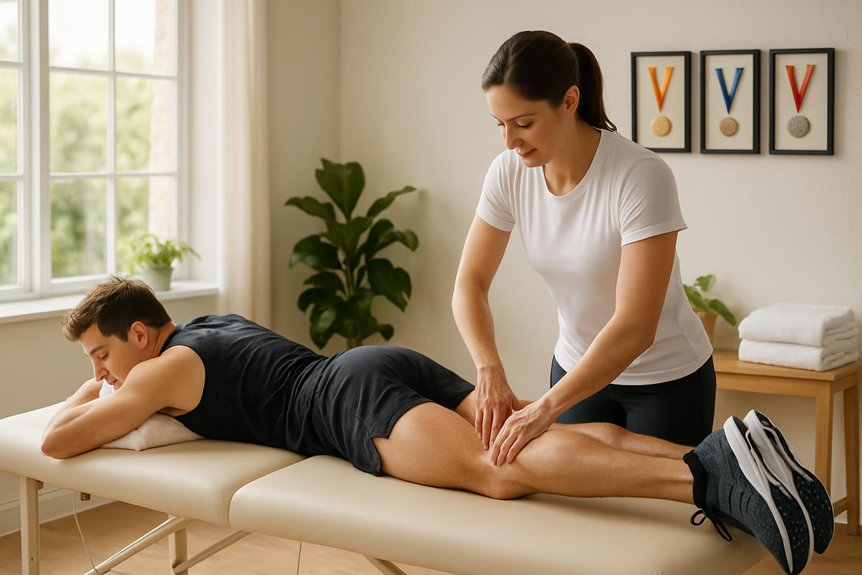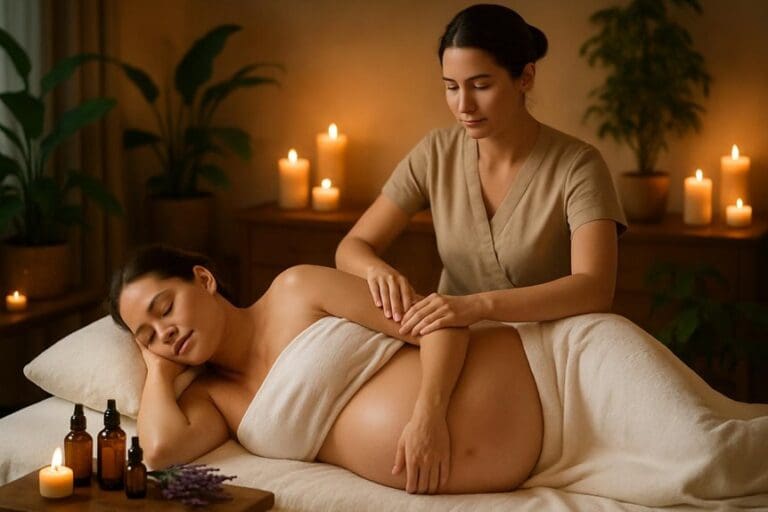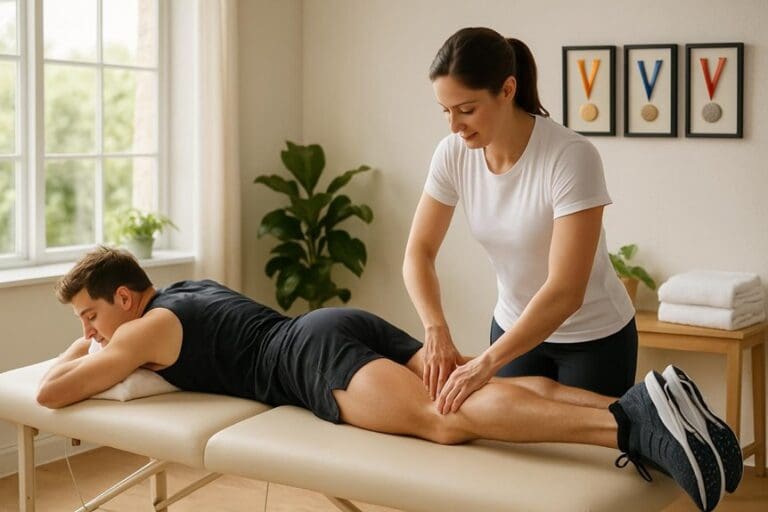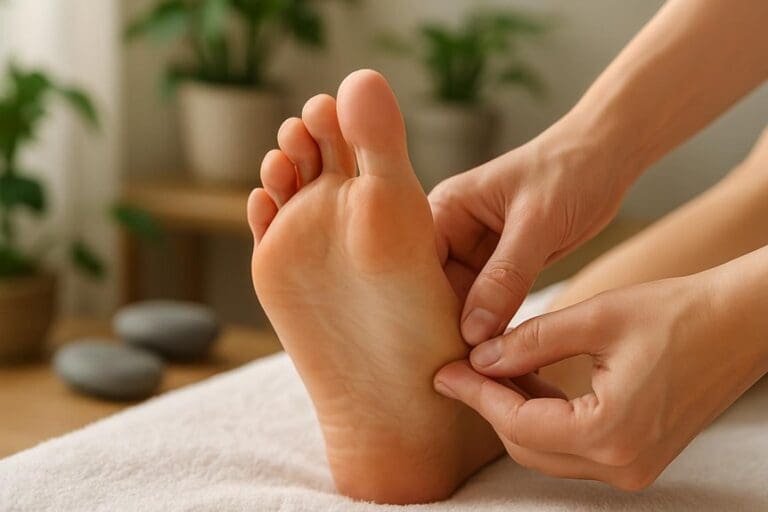Most active people benefit from athletic massage every 2–4 weeks. During peak training or injury flares, weekly sessions—occasionally twice weekly—can improve recovery, tissue extensibility, and range of motion. Schedule moderate-pressure work 24–48 hours after hard sessions and lighter techniques 48–72 hours before competitions. Beginners may start every 2–3 weeks for 6–8 weeks, then taper. Indicators to increase frequency include persistent soreness, tightness, reduced ROM, and delayed recovery. Hydration, mobility, and sleep consolidate gains; specific protocols vary by goals and phase.
Understanding the Role of Sports Massage in Training and Recovery

While training volume and intensity drive adaptation, athletic massage supports these processes by modulating soft-tissue load, restoring range of motion, and reducing perceived muscle soreness.
Evidence indicates that targeted manual therapy can reduce neuromuscular tone, improve local circulation, and influence pain perception via mechanoreceptor input.
In performance phases, it helps maintain tissue extensibility and joint glide, aiding efficient movement patterns and reducing compensations that invite overload.
At Spa & Massage, therapists assess movement, palpate for trigger points, and apply graded pressure, myofascial techniques, and assisted stretching to address adhesions without provoking excess inflammation.
Post-session guidance includes hydration, light mobility, and sleep prioritisation to consolidate gains.
Clients report clearer muscle feel, easier stride mechanics, and calmer recovery days—quiet signals that training is landing where it should.
Just as pregnancy massage offers relief and wellness benefits for expecting mothers, athletic massage delivers targeted support for athletes to optimise recovery and bolster overall well-being.
Factors That Determine Your Ideal Massage Frequency
Massage frequency is primarily shaped by an athlete’s training load and goals, with higher-intensity or peak-phase cycles warranting more frequent sessions than maintenance periods.
Current recovery status and any acute or chronic injuries further adjust timing, often shifting toward shorter intervals (e.g., weekly) during flare-ups and tapering as symptoms resolve.
At Spa & Massage, therapists assess workload, tissue reactivity, and symptom trends to set an evidence-based schedule that supports performance while preventing overload.
Training Load and Goals
An individual’s training load and performance goals are primary determinants of athletic massage frequency. Higher weekly volume, intensity, and competition demands increase neuromuscular strain and warrant more frequent sessions.
For endurance or mixed-modal athletes training 5–7 days weekly, a weekly athletic massage helps maintain tissue compliance and movement quality. Strength or power cycles with high eccentric loads may benefit from 7–10 day intervals. Technique-focused phases can taper to biweekly.
Athletes targeting personal bests or event peaks often schedule progressive blocks: weekly in the final 4–6 weeks, then brief, lighter sessions in race week.
At Spa & Massage in London, therapists calibrate cadence to training logs and goals, integrating targeted myofascial and neuromuscular techniques to support workload tolerance and consistent, confident performance.
Recovery and Injury Status
Beyond training load and goals, recovery capacity and current injury status directly influence ideal frequency. Athletes with robust sleep, balanced nutrition, and low baseline soreness often maintain benefit with athletic massage every 10–14 days.
Those with delayed recovery, persistent tightness, or high stress typically respond better to weekly sessions until markers improve.
Acute injuries warrant a phased approach. In our London clinics, therapists avoid aggressive techniques early; gentle lymphatic work and pain-modulated pressure may be used 48–72 hours post-injury, progressing to focused tissue work as swelling subsides.
For tendinopathies or recurrent strains, 1–2 targeted sessions per week for 2–4 weeks can support load tolerance, then taper to maintenance.
Clear indicators to extend intervals include waking refreshed, reduced DOMS, stable range of motion, and pain ≤2/10 during activity.
How Often to Book During Peak Training Cycles
During peak training blocks, frequency should align with load, intensity, and athlete history. Most athletes tolerate a weekly athletic massage, while those on high-volume or two-a-day programs benefit from 2 sessions per week for short windows (1–3 weeks).
This cadence supports tissue perfusion, modulates tone in overworked muscle groups, and helps maintain range without provoking fatigue.
Athletes with prior tendinopathy or recurrent hotspots often require closer spacing early in a peak, then taper to weekly.
At Spa & Massage, therapists plan session focus by phase: early-peak uses firmer techniques on prime movers; mid-peak shifts to moderate depth with targeted myofascial release; late-peak favors lighter flushing to preserve freshness.
Appointments are kept to 45–60 minutes, region-specific, with therapist-led reassessment guiding interval adjustments.
Scheduling Around Competitions and Events
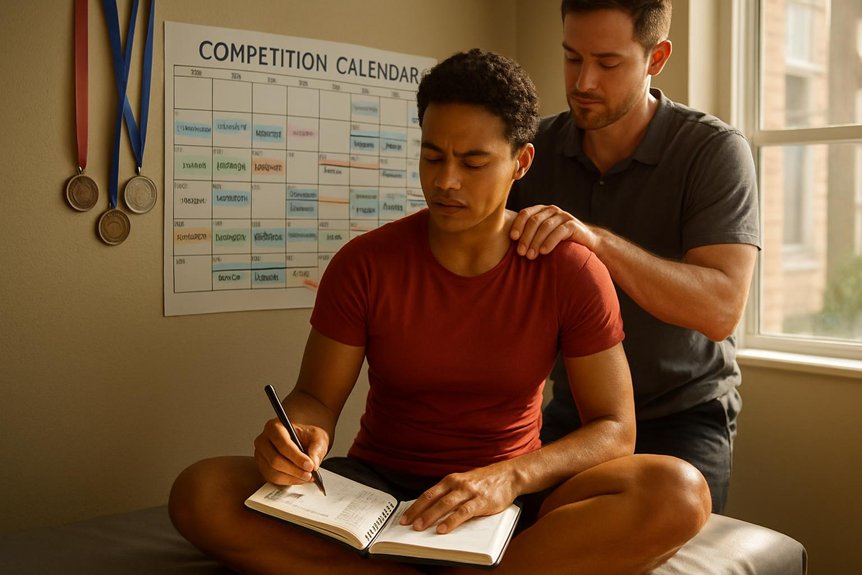
How best to time athletic massage around race day depends on event demands, recovery profile, and individual response to pressure.
Evidence supports light, non-provocative work 48–72 hours before competition to reduce tone without inducing soreness. A brief tune-up 24–36 hours out suits athletes who tolerate pressure well; deeper techniques are avoided.
Post-event, gentle flushing within 2–6 hours can aid comfort, with a more thorough session at 24–72 hours to address hotspots once acute inflammation settles.
At Spa & Massage clinics in London, therapists individualise timing by event type (sprint, endurance, multi-stage), travel stress, and known trigger points.
They track tissue response across cycles, adjusting pressure and duration.
Clients often pair pre-event sessions with breath-led downregulation; post-event, therapists prioritise fluid movement, pain-modulated techniques, and sleep support.
Recommendations for Recreational Exercisers and Beginners
New to training or exercising a few times per week, what cadence of athletic massage is appropriate?
For most beginners and recreational exercisers, Spa & Massage recommends a athletic massage every 3–4 weeks to support tissue adaptation, reduce delayed-onset muscle soreness, and maintain range of motion.
In early phases (first 6–8 weeks), a slightly higher frequency—every 2–3 weeks—can help manage novel training loads and encourage consistent recovery habits.
Sessions should be moderate in pressure, 45–60 minutes, targeting primary movers used in current routines. Our therapists prioritise myofascial techniques, graded pressure, and active-assisted stretching to address manageable tightness without provoking soreness.
Between visits, our clinicians advise simple mobility drills, hydration, and gentle self-massage.
Clients across London appreciate this cadence for keeping workouts comfortable, progress steady, and bodies responsive.
Managing Injuries and Chronic Tightness With Targeted Sessions
For injury management, an acute flare-up plan prioritises brief, low-intensity, pain-tolerant sessions focused on reducing tone and swelling, typically 24–72 hours post-onset alongside medical guidance.
For chronic tightness, a protocol of targeted soft-tissue work every 1–2 weeks, complemented by therapist-prescribed mobility and load management, maintains tissue extensibility and reduces recurrence.
Post-injury progression shifts to deeper, sport-specific techniques at increasing intervals (e.g., weekly to fortnightly), aligned with functional milestones and response to load.
Acute Flare-Up Plan
When an injury flares or chronic tightness spikes, timely, targeted intervention reduces pain and restores function. In our London clinics, therapists prioritise a focused plan: brief assessment, pain mapping, and goal setting.
For acute episodes, evidence supports short, clustered athletic massage sessions—20–30 minutes, 2–3 times in the first 7–10 days—using gentle friction, graded pressure, and myofascial release to modulate nociception and reduce guarding. Techniques avoid provoking inflammation; cross-fibre work and lymphatic strokes are dosed conservatively.
Between visits, our therapists recommend heat for stiffness, ice for reactive pain, and light mobility twice daily. Clients are advised to avoid heavy loading for 48 hours, then reintroduce activity with symptom-guided pacing.
We use unscented or light arnica-infused oils to minimise irritation. Progress is reviewed at day 10 to confirm de-escalation or adjust care.
Chronic Tightness Protocol
Although chronic tightness is rarely urgent, it is persistent and multifactorial, requiring structured, progressive care. At Spa & Massage, therapists apply a phased protocol: assessment-led athletic massage weekly for 3–4 weeks, then tapering to fortnightly, and later monthly maintenance.
Sessions target myofascial adhesions, trigger points, and neurodynamics, using graded pressure, active release, and contract–relax techniques. Evidence supports combining manual therapy with load management and mobility work to improve range and reduce pain.
Therapists emphasise consistency and precision: priority areas first, adjacent chains second, global pattern last. Clients receive simple homework—daily breathing drills, 5–8 minutes of mobility, and light eccentric loading—to lock in gains.
Oils are chosen for glide without residue, enabling nuanced palpation. Progress is tracked via ROM metrics and symptom change, adjusting frequency accordingly.
Post-Injury Progression
Post-injury recovery benefits from a staged plan that aligns tissue healing timelines with graded loading and targeted athletic massage.
In acute phases (days 1–7), gentle lymphatic drainage and pain-modulated techniques reduce swelling and guarding; sessions are brief, 20–30 minutes, every 3–4 days.
In subacute phases (weeks 2–6), therapists progress to specific myofascial work, cross-fibre friction, and assisted range-of-motion, typically weekly, coordinated with physiotherapy and strength milestones.
At Spa & Massage clinics across London, therapists tailor pressure, vectors, and dosage to the involved tissue—tendon, muscle, or fascia—while monitoring irritability and next-day response.
In later rehabilitation, sessions move to biweekly, then monthly, focusing on load tolerance, scar mobility, and movement integration.
Clear home advice—heat/cold dosing, breathwork, gentle mobility—supports sustained recovery.
Signs You’re Overdue for a Sports Massage
A pattern of persistent muscle tightness, reduced range of motion, and delayed recovery after training often indicates the need for a athletic massage. Additional warning signs include morning stiffness that eases slowly, recurring “hot spots” or trigger points, asymmetrical muscle tension, and compensatory movement patterns.
Sleep disruption from aching limbs, frequent DOMS beyond 48–72 hours, or a plateau in strength or speed despite consistent training also suggest overload.
When these signals cluster, a targeted athletic massage is indicated. At Spa & Massage clinics in London, therapists assess tissue tone, joint play, and pain provocation to guide pressure, pacing, and technique.
Clients often report immediate ease, warmer tissues, and smoother stride mechanics. If symptoms return quickly, frequency is adjusted to restore resilient baseline function.
How to Integrate This Type of Massage With Strength, Mobility, and Rest Days
When the warning signs of overload appear, timing athletic massage alongside training variables becomes a programming decision rather than an add-on.
Evidence supports scheduling moderate‑pressure athletic massage 24–48 hours after heavy strength sessions to reduce perceived soreness without impairing adaptation.
On mobility days, brief targeted work before drills can down‑regulate tone in overactive tissues, then finish with active range to consolidate gains.
On rest days, a longer session aids parasympathetic recovery and sleep quality.
At Spa & Massage, therapists prioritise glutes, calves, hamstrings, and thoracic structures for runners and lifters, using graded pressure, myofascial techniques, and joint mobilisations.
Frequency is anchored to load: weekly during high‑intensity blocks; every 2–3 weeks in maintenance.
Clients are advised to hydrate, walk lightly after sessions, and avoid maximal lifting for 12–24 hours.
What to Expect From a Personalised Plan at Spa & Massage London
From the initial assessment, a personalised athletic massage plan at Spa & Massage London is built around the client’s training load, performance goals, injury history, and recovery markers.
Therapists quantify baseline range of motion, tissue tone, pain provocation, and sleep quality, then set measurable targets.
Frequency typically ranges from weekly during heavy blocks to biweekly or monthly in maintenance, with taper adjustments before key events.
Sessions combine deep tissue, myofascial techniques, trigger point release, and assisted stretching, supported by targeted self-care.
In our clinics, therapists use hypoallergenic oils and pressure titrated to tolerance, monitoring DOMS, HRV, and perceived recovery.
Clients receive simple mobility drills, hydration and sleep guidance, and clear red-flag thresholds.
Plans are reviewed every 4–6 weeks, ensuring progress remains specific, safe, and intimate.
Conclusion
In the end, frequency is not a guess but a gradient: higher during peak load, tapered pre‑event, reduced in off‑season, and responsive to signs like persistent tightness or reduced range. Evidence supports regular athletic massage to ease muscle tension, enhance mobility, and accelerate recovery when aligned with training phases. Listeners to their bodies—and their data—will benefit most. At Spa & Massage London, tailored plans translate goals into cadence, ensuring sessions land where they matter: before strain whispers, before soreness shouts.
